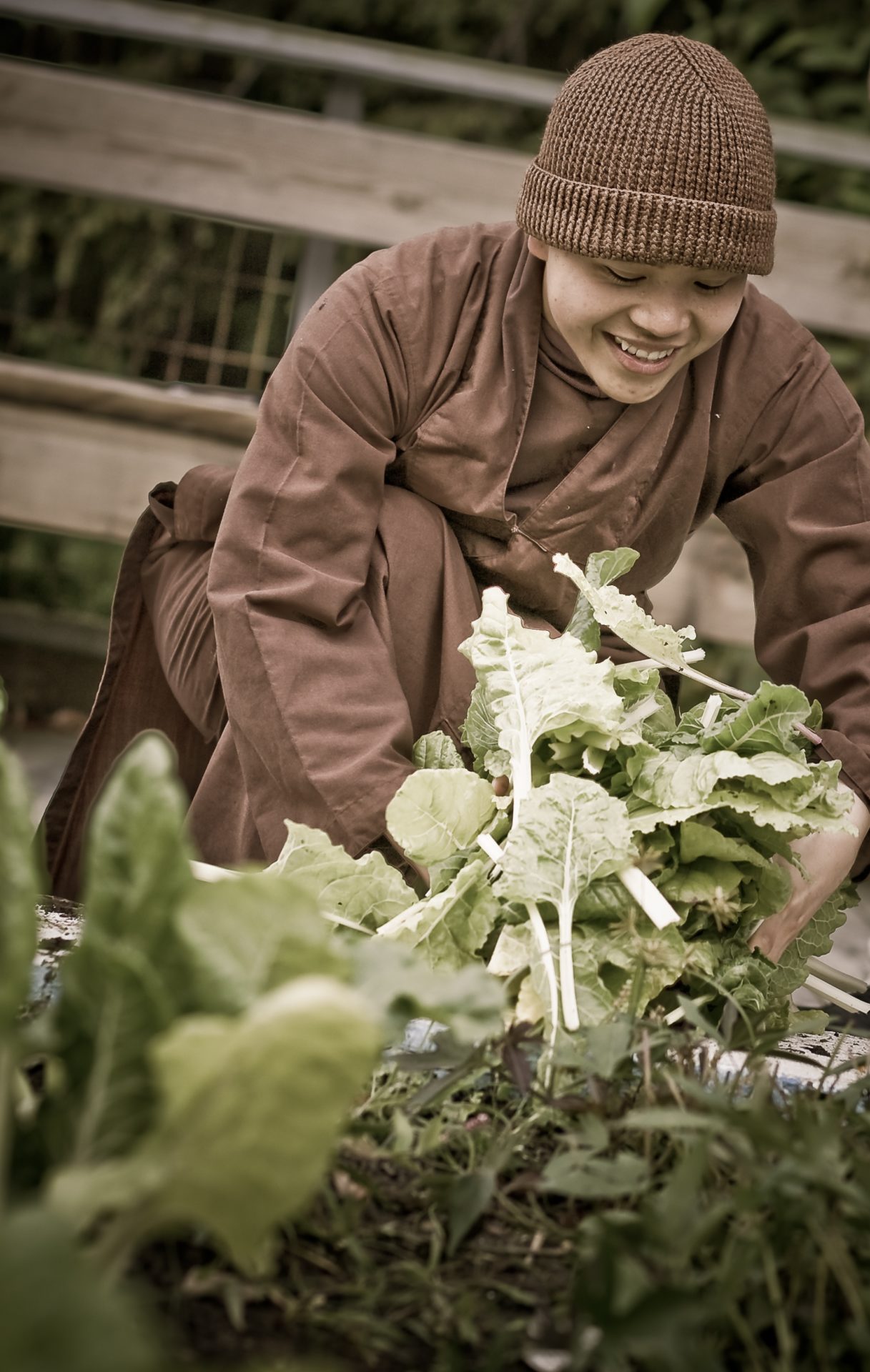By Leslie J. Davis in October 2017
The Sangha dwells in mindfulness day and night, providing the foundation for us to realize the fruit of meditation. – Thich Nhat Hanh
Thich Nhat Hanh writes, in his book The Heart of the Buddha’s Teaching, “Sangha is the fourfold community of monks, nuns, laymen, and laywomen, as well as the other elements that support our practice—our cushion,
By Leslie J. Davis in October 2017
The Sangha dwells in mindfulness day and night, providing the foundation for us to realize the fruit of meditation. – Thich Nhat Hanh
Thich Nhat Hanh writes, in his book The Heart of the Buddha’s Teaching, “Sangha is the fourfold community of monks, nuns, laymen, and laywomen, as well as the other elements that support our practice—our cushion, our walking meditation path, the trees, the sky, and the flowers.” In the Buddhist tradition of Thich Nhat Hanh, a Sangha is a group of meditation practitioners who sit together in a circle, backs facing one another, eyes facing the wall or the outside of the circle. When I sit meditating in a circle like this, I feel a tremendous strength and energy, as if all of our practicing is holding each other up as we meditate, and then as we go out as individuals to face life and all its challenges.
When my son was born I knew very little about Buddhism, let alone the meaning of the word Sangha, but I often likened my nursing to a “practice.” It took such a deep commitment, and often it was such hard work to just sit still. I considered nursing to be my spiritual work. It was my quiet time, my time for solitude and a sweet togetherness with my child. My relationship to nursing had a sinuous path, as spiritual discovery can, but I was motivated by its wonder and pursued its winding course.
I nursed my son from the tender beginnings of skin-on-skin bonding just moments after his slippery entrance into this world, until a few months after his second birthday, when he gracefully weaned himself from my breast. But many, many times it took so much concentration and self-discipline to sit there, just sit there, doing nothing, being still, feeding my baby and waiting for him to finish. I’d fly through the full range of emotions-all, sometimes, within a single nursing session: love, joy, gratitude, serenity, irritation, anger, fear, impatience, selfishness, guilt, hopelessness, and despair. I’d fantasize that my body could get up and cook, clean, go to the bathroom, while my nipple stayed there in the chair nursing the baby. I’d stare out the window at people passing by our San Francisco apartment, envious of the fantastic adventures they were living while I was stuck in my chair, ruled by his tiny mouth. While I nursed, I’d return calls, look through mail, and try to keep up with all the details of my life. (1)
After about six months of this, I gave up and gave in. With each day that passed, I saw myself more and more as a mother, as a nursing mother, as a woman devoted to her child and to the importance of breastfeeding. I became an advocate for breastfeeding, trying to encourage it among all my friends and acquaintances. I awoke to the miracle of my milk and this intimate dance of nursing my child. A calmness began to quiet my restless energy, pulling me into the present moment. As Myla Kabat-Zinn says in her book, Everyday Blessings: The Inner Work of Mindful Parenting, “As I felt my milk let down, a wonderful haziness descended on me, and everything else became less important. I let go of the things I had planned to do, and instead let myself be pulled into the present moment, into being totally with my baby. It was a deeply meditative time for both of us.”
One sunny afternoon we were nursing in our “big blue chair” (as we like to call our comfortable rocker), and I realized that I’d never before devoted myself to something so entirely. Of course I’ve devoted myself to my husband, to my family, to friends, to my writing, to mothering, and even to God and other spiritual endeavors at various points in my life. But in that moment I realized that, as a breastfeeding mother, I’d completely given myself to this act of nursing in a way that I never had before. Nothing was more important than nursing my son. Nothing was put before it. There was no procrastination as with exercise, no excuses as with trying to stop eating sugar, no laziness as with housecleaning and other chores. Nursing had to be done, and I did it, over and over again, multiple times a day, for more than 800 days in a row. It was the closest thing to a spiritual practice that I’d ever experienced.
I began practicing deep breathing while I was nursing. Breathing in, I am nursing my lovely baby. Breathing out, I am mother. I tried several hundred variations on this theme: Breathing in, I love my baby. Breathing out, I feel calm. Breathing in, my baby wants milk. Breathing out, milk flows freely.
I wrote nursing haiku. I turned my “nursing corner” into a sacred place by doing such simple things as keeping it clean, putting a flower in a glass of water on my dresser, making sure I had what I needed (pillows, water, etc.) so I could relax and enjoy the precious act of nursing. I spent endless hours watching my son nursing at my breast—the most beautiful sight in the world—but I also spent a lot of time getting to know patterns of light moving across the rooms of our home, the swaying of the birch tree outside our window, the shadows of our camphor tree. I became a lover of sounds—birdsongs, raindrops, traffic, wind, sirens, and neighbors talking. All these things were woven into my nursing practice.
In the middle of the night I’d think, As I lie here nursing my babe, thousands of women all over the world are nursing theirs. Especially on those nights when my son wanted to nurse all night long, I’d bring myself back to that joyous vision—in my mind, I’d imagine all of the nursing mothers I knew, each of them awake or half-awake in the middle of the night, nursing their babies. Like a Sangha, they were part of my nursing community—they were my air, my sky, my sunshine. Their commitment to their nursing practice made my commitment grow stronger. Their practice made my practice seem easier.
“Take refuge in the Sangha, and you’ll have the wisdom and support you need,” says Thich Nhat Hanh in The Heart of the Buddha’s Teaching. I felt such comfort from my nursing community in the dark of night, even though I was the only woman nursing in our house. In bed, with my son at my breast making his sing-song nursing noises, and my husband’s hand resting on my hip, I was supported in this act, completely loved, and nurturing my child with mother’s milk.
Now that I am a practitioner and a member of a meditation Sangha, this concept is even more profound to me. Now, when I sit practicing mediation, I feel my body connect with the earth, I feel my breath going in and my breath going out. That full spectrum of emotion washes over me as it did when I sat nursing, so I practice saying hello to my feelings, and practice letting them go so I can just sit, enjoy my breathing, and the comfort and support of my Sangha.
1 Author's note: This article was written in a world before smartphones. If I'd had a smartphone, I would have been obsessively checking email, Facebook, and Instagram.
For more information on nursing: La Leche League International, www.lalecheleague.org.
This article was originally published in Mothering Magazine (Issue 120, September/October 2003; www.mothering.com/articles/breathing-in), and has been reprinted with permission.


